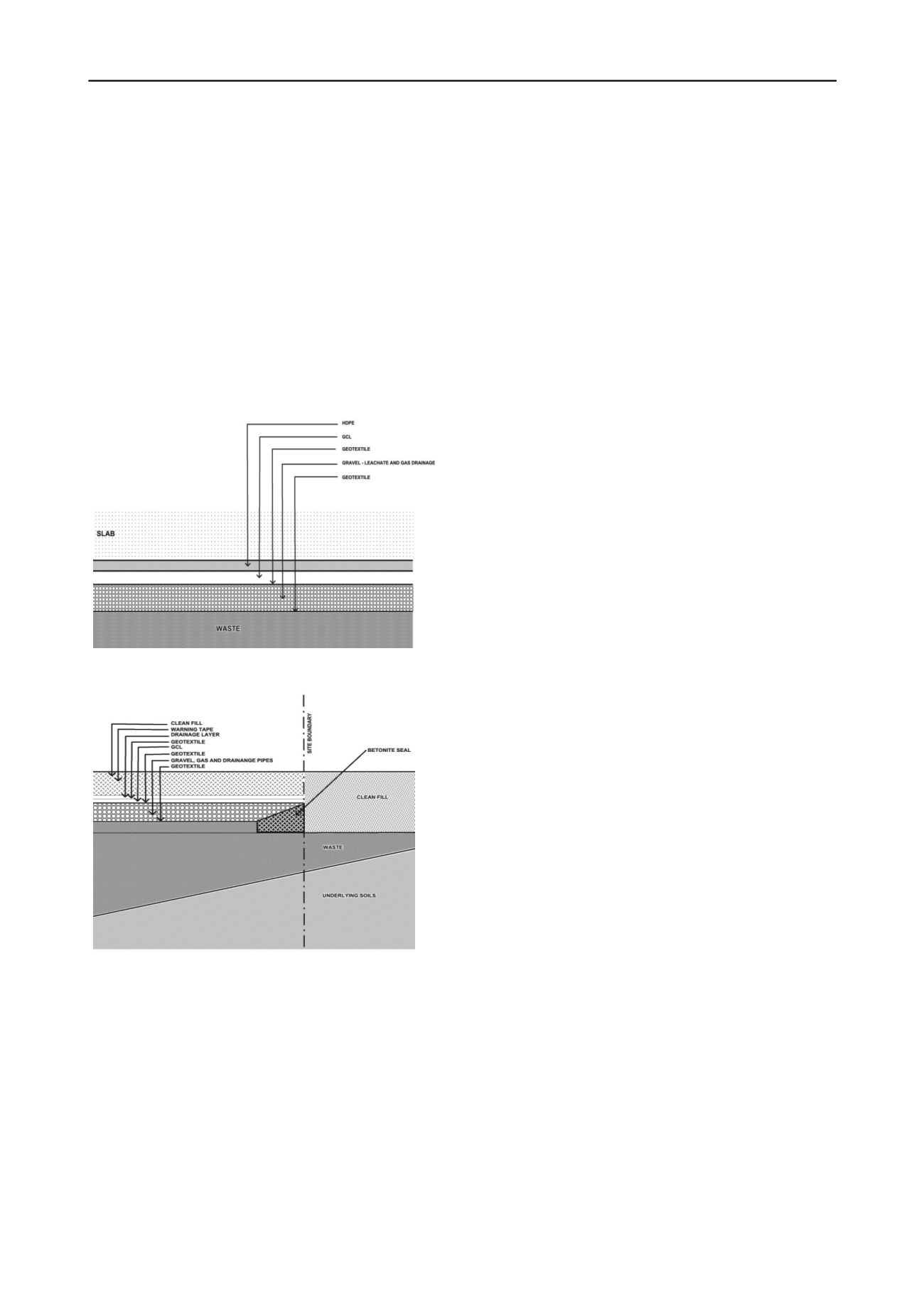
3238
Proceedings of the 18
th
International Conference on Soil Mechanics and Geotechnical Engineering, Paris 2013
extent 50 m beyond the landfill boundary or the site boundary
whichever occurs first. At the landfill boundary within the site,
the capping will be keyed in with a sump installed for leachate
and landfill gas condensate collection.
7 LESSONS LEARNT DURING CONSTRUCTION
Where the landfill extends over the site boundary a bentonite
plug will be installed at the boundary to minimise migration of
landfill gases through soils, refer to Figure 6.
Of particular interest to those wanting to apply the techniques
described in this paper for another site or project, are the lessons
learnt during the construction of this project. Primarily, these
are as follows:
Landfill gas drainage will consist of a gas drainage layer
forming part of the cap. Collection pipes will be placed around
the perimeter and across the benches with a maximum spacing
of 50 m. An additional gas extraction filter layer and pipe work
for the collection and discharge of LFG will be incorporated
beneath the slab of all buildings where possible. Three remedial
options for the management landfill gas were considered. The
use of landfill gas for power generation was not considered
feasible due to low gas flows as result of the age and stage of
the decomposition of the waste present at the site this option
1. The site was located within 50m of a main highway. A
hazard was ‘fly rock’ being mobilized during dynamic
compaction and hitting operators or leaving the site and
colliding with a vehicle on the highway. To control this
hazard, a no-go zone was established around the dynamic
compaction rig and the rig was not allowed to operate
near the highway.
2. The extent of consolidation during dynamic compaction was
significant. At this site, the contaminated water make
during dynamic compaction was also significant. Whilst
this was predicted and readily catered for onsite (in
accordance with the CEMP) it took a considerable amount
of time to manage, sample for contamination and then
subsequently discharge at an appropriate location. It was
also relatively expensive.
3. The use of coal washery rejects, a mining by-product from
the coal washing process, was entirely successful. This
material was put to use on this site and would otherwise
have ended up as landfill. The ability to use what would
otherwise have been waste material, as fill material in the
overall remediation of another landfill site, is considered
best
practice
and
an
outstanding
outcome
environmentally.
4. The selection of an earthworks contractor must include an
assessment of their ability to perform the work rapidly.
Exposing the waste sections of the site created many
hazards, and the contractors ability to perform the work
and ‘cap’ the site ready for dynamic compaction in the
shortest possible timeframe greatly reduces the exposure
to those hazards and any expensive delays caused by (for
example) inclement weather.
Figure 5: Preliminary design of cap for slab on ground
8 CONCLUSION
The use of dynamic compaction and construction of a landfill
gas drainage system together with innovative civil solutions will
allow the Fo Guang Shan Nan Tien Buddhist Order to develop
their site and create a teaching and cultural facility as part of the
existing Nan Tien Temple. Geotechnical and environmental
performance was monitored during site preparation works and
will be monitored during building construction.
9 ACKNOWLEDGEMENTS
The authors acknowledge the Fo Guang Shan Nan Tien
Buddhist Order and affiliates for assistance in the project and
their permission to use project specific data for this paper.
Figure 6: Preliminary design of cap at site boundary
Flaring of the gas, with ignition of the gas as it leaves the site
was considered, given its advantage of reducing the landfill gas
to a higher percentage of CO
2
and H
2
O vapour, however the
technical difficulties of operating the flare, the area required for
a flare plant and the cost of setting up and maintenance of the
plant, among others, far outweighed the advantages. The final
remedial option, venting to the atmosphere, was chosen for the
zero requirements for a specific treatment plant and operating
costs. As such the preliminary design consists of the placement
of turbine ventilator stacks around the site. Landfill gas
discharge will occur through stacks that will extend 1 m above
the proposed maximum building roof level across the site. To
monitor the landfill gas and minimise the potential of migration
off-site a series of monitoring wells will be installed.
10 REFERENCES
Standards Australia. 1993. Determination of the penetration resistance
of a soil – Standard Penetration Test.
Australian Standard AS 1289
6.3.1 – 1993.
Standards Australia. 1996. Guidelines on earthworks for commercial
and residential developments.
Australian Standard AS 3798 –
1997
.
Hausmann, M.R. 1990. Engineering Principals of Ground Modification.
McGraw Hill
.
Thom, M.J. 1998. The long term settlement behaviour of waste and its
effect on future development.
3
rd
National Hazardous and Solid
Waste Convention.
Department of Environment and Conservation NSW. 2006. Guidelines
for the NSW Site Auditor Scheme.
2
nd
Edition.


